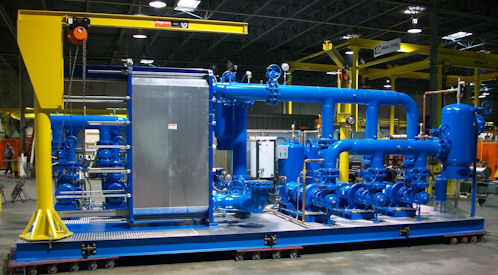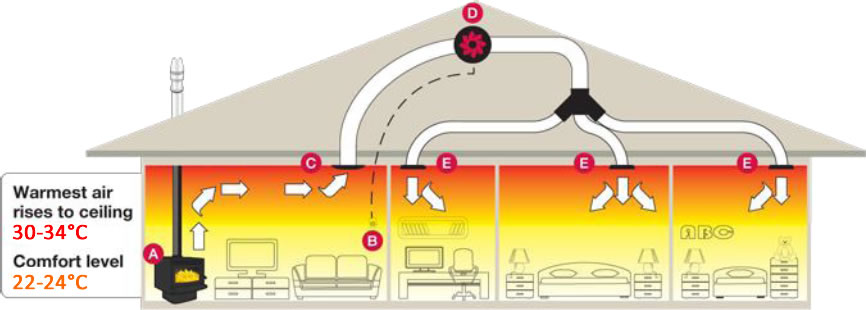Exploring the Benefits and Applications of Heat Transfer Equipments in Modern Sector
Heat transfer systems play a crucial duty in contemporary market. They encompass various systems such as convection, radiation, and conduction, each adding to reliable thermal administration. Industries like manufacturing and aerospace advantage significantly from these systems. As developments proceed, the integration of innovative materials and technologies promises to enhance power effectiveness. This advancement raises important inquiries regarding the future implications for sustainability and functional expenses throughout several markets. What lies in advance in this continuous transformation?
Understanding Heat Transfer Principles
Heat transfer principles are fundamental to the procedure of various commercial systems. These principles include the mechanisms of radiation, conduction, and convection, each playing a crucial role in handling thermal energy. Recognizing conduction includes analyzing how Heat moves with strong materials, while convection refer to Heat transfer in fluids, driven by fluid activity. Radiation, distinct from the various other two, involves energy transfer with electro-magnetic waves. The effectiveness of Heat transfer impacts system performance, power intake, and overall efficiency. Reliable thermal management is crucial in processes such as Heat, cooling, and home heating healing. By grasping these concepts, sectors can maximize their operations, decrease energy expenses, and boost devices long life, therefore adding to a more sustainable and effective commercial landscape.
Key Types of Heat Transfer Solutions
While various sectors make use of Heat transfer systems for diverse applications, several essential types stick out as a result of their details features and effectiveness. The most typical types consist of convection, radiation, and conduction systems. Conduction systems transfer Heat via straight get in touch with between materials, making them reliable in solid-state applications. Convection systems, on the various other hand, use fluid motion to transfer Heat, ideal for home heating or cooling gases and liquids. Radiation systems run without a medium, counting on electro-magnetic waves to transfer Heat, ideal for high-temperature environments. Each type serves distinct purposes, permitting markets to tailor their Heat transfer remedies based upon operational needs, power performance, and cost-effectiveness. Comprehending these systems is crucial for maximizing performance in various commercial setups.
Industrial Applications of Heat Transfer Technologies
The application of Heat transfer innovations in industry plays an important duty in improving energy efficiency and maximizing processes. DVS Heat Transfer Systems. By implementing innovative Heat exchange systems, firms can substantially decrease their ecological effect while improving total efficiency. This integration not just cultivates sustainability yet likewise straightens with contemporary governing and consumer needs for greener methods
Power Efficiency Improvements
As sectors increasingly focus on sustainability, energy performance improvements in Heat transfer technologies have come to be vital for lowering operational prices and environmental effect. Boosted Heat exchangers, for example, make use of advanced materials and styles to make the most of thermal performance while minimizing power intake. Incorporating variable speed drives in pumping systems enables for much better control of liquid circulation, leading to substantial power cost savings. The implementation of smart sensors and automation supplies real-time surveillance, making it possible for adjustments that enhance power usage. In addition, waste Heat recuperation systems record excess thermal power, transforming it right into functional power. These innovations not just improve power efficiency but also contribute to a more sustainable industrial landscape by reducing greenhouse gas discharges and sustaining compliance with environmental regulations.
Refine Optimization Techniques
Refine optimization strategies are crucial in enhancing the efficiency and effectiveness of Heat transfer modern technologies in commercial applications. These strategies entail refining procedures to make the most of Heat transfer efficiency while minimizing power usage and operational prices. Techniques such as computational fluid dynamics (CFD) modeling permit designers to replicate and examine Heat transfer scenarios, recognizing locations for enhancement. Additionally, real-time surveillance systems can supply important information on temperature gradients and circulation rates, enabling adjustments that maximize efficiency. Carrying out advanced control approaches, such as predictive analytics, can enhance system responsiveness to varying functional demands. By using these optimization techniques, industries can achieve better thermal efficiency, lowered downtime, and enhanced item quality, inevitably resulting in enhanced competitiveness in the marketplace.

Environmental Impact Reduction
While industrial Heat transfer innovations are important for functional efficiency, their application additionally presents possibilities for significant ecological effect decrease. By improving power efficiency, these systems lessen gas intake, causing lower greenhouse gas discharges. For example, advanced Heat exchangers can recuperate waste Heat, rerouting it to preheat incoming fluids, consequently reducing energy requirements. Additionally, the combination of Heat transfer innovations in renewable energy systems, such as solar thermal and geothermal applications, supports the change to sustainable practices. Industries that use these modern technologies additionally gain from lowered operational prices and improved regulatory compliance. In general, the critical application of Heat transfer systems not just reinforces performance however also cultivates a much more lasting industrial landscape, contributing to worldwide ecological goals.
Advantages of Reliable Heat Transfer Solutions
Efficient Heat transfer systems offer substantial benefits in contemporary industry, largely through enhanced power effectiveness and price reduction. By optimizing thermal monitoring, these systems decrease power waste, leading to lower functional expenses (DVS Heat Transfer Systems). Organizations can achieve higher sustainability and boosted success.

Energy Efficiency Improvements
As industries increasingly focus on sustainability and cost-effectiveness, energy efficiency renovations in Heat transfer systems have emerged as an essential emphasis. Enhanced efficiency in these systems leads to lowered energy consumption, enabling facilities to operate even more sustainably. By enhancing Heat transfer approaches, sectors can decrease waste Heat and attain far better thermal monitoring, substantially decreasing their environmental effect. Advancements in innovations such as Heat exchangers and Source insulation materials add to enhanced efficiency and dependability. Executing energy-efficient Heat transfer remedies not just supports conformity with regulative requirements however also cultivates a society of development within organizations. Inevitably, these enhancements are vital in aligning commercial procedures with worldwide energy preservation goals, leading the method for a more lasting future in manufacturing and handling industries.
Expense Decrease Opportunities
By enhancing Heat transfer systems, markets can disclose substantial price reduction opportunities that boost their profits. Effective Heat transfer minimizes energy intake, bring about lower energy bills and decreasing operational expenditures. Additionally, improved system efficiency reduces the demand for maintenance and fixings, furthermore saving prices over time. Enhanced Heat transfer can also extend devices life-span, allowing business to postpone capital expenses on replacements. In addition, waste Heat recuperation systems can transform excess Heat right into useful power, better driving down expenses. These systems not only enhance procedures but likewise contribute to sustainability efforts, positioning business positively in a progressively eco-conscious market. Overall, the financial advantages of reliable Heat transfer systems are considerable and essential for affordable benefit.
Technologies in Heat Transfer Solutions
How can modern-day industry enhance its operations with ingenious Heat transfer options? By taking on innovative products and modern technologies, markets can substantially boost thermal performance and efficiency. Technologies such as nanofluids, which boost Heat transfer capabilities past traditional fluids, and phase change materials that save and launch thermal power, are getting traction. Additionally, the integration of clever sensing units i was reading this and IoT gadgets permits real-time surveillance and optimization of Heat transfer procedures, lowering waste and boosting system responsiveness. Additionally, additive manufacturing techniques enable the production of even more complicated Heat exchangers that optimize area while reducing material use. Collectively, these developments drive functional effectiveness and create affordable advantages in various fields, including energy, manufacturing, and aerospace.
The Function of Heat Transfer in Sustainability Efforts
While the promote sustainability remains to improve sectors, the role of Heat transfer technologies becomes progressively vital in attaining ecological objectives. Efficient Heat transfer systems facilitate energy performance by optimizing thermal management in numerous processes, substantially reducing energy intake and greenhouse gas emissions. As an example, advanced Heat exchangers are made use of in commercial applications to reclaim waste Heat, thus decreasing energy waste. In addition, developments such as stage change materials improve thermal storage space, adding to sustainable energy integration. In addition, the fostering of lasting fluids in Heat transfer systems can decrease ecological influence. By focusing on efficient Heat transfer, industries not only enhance operational performance but likewise line up with worldwide sustainability initiatives, cultivating a cleaner, more sustainable future.
Frequently Asked Inquiries
Exactly How Do Heat Transfer Solutions Effect Energy Expenses in Manufacturing?
Heat transfer systems substantially influence energy costs in manufacturing by enhancing efficiency, reducing waste, and optimizing thermal find out here management. These renovations bring about decrease functional expenditures, inevitably profiting general efficiency and earnings in industrial operations.
What Upkeep Is Needed for Heat Transfer Systems?
Upkeep for Heat transfer systems consists of regular inspections, cleansing of elements, inspecting fluid degrees and problems, replacing used components, and making sure proper insulation. These activities improve effectiveness, extend life-span, and stop costly malfunctions in operation.
Are There Security Interest In Heat Transfer Equipments?
Safety interest in Heat transfer systems consist of prospective leakages, pressure build-up, and thermal threats. Appropriate layout, regular upkeep, and adherence to safety procedures are important to minimize these risks and ensure secure operation in industrial settings.
How Can I Pick the Right Heat Transfer System for My Organization?
Selecting the right Heat transfer system entails assessing variables such as effectiveness, application demands, spending plan restrictions, and safety and security standards. A detailed analysis of these aspects will certainly aid guarantee optimal efficiency and integrity in business operations.
What Are Typical Failures in Heat Transfer Equipments and Their Reasons?

Understanding conduction involves assessing exactly how Heat relocates with solid products, while convection pertains to Heat transfer in fluids, driven by fluid activity. By maximizing Heat transfer methods, markets can decrease waste Heat and attain much better thermal management, significantly lowering their environmental impact. Waste Heat healing systems can transform excess Heat right into usable energy, additionally driving down prices. Progressed Heat exchangers are utilized in industrial applications to recover waste Heat, therefore reducing energy waste. Typical failings in Heat transfer systems consist of leakages, deterioration, and ineffective Heat exchange.